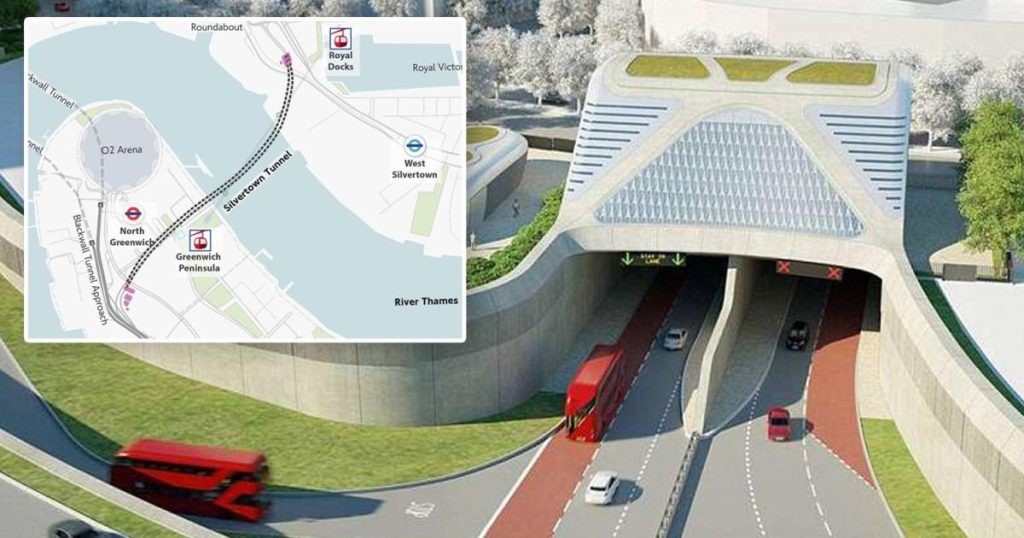The Silvertown Tunnel: A New Cross-River Connection for London
London’s transportation network is set for a significant expansion with the upcoming opening of the Silvertown Tunnel, a new sub-river passage linking the Greenwich peninsula and the borough of Newham. Scheduled to open on April 7th, this nearly mile-long tunnel aims to alleviate the chronic congestion plaguing the existing Blackwall Tunnel, a Victorian-era crossing that has long struggled to cope with modern traffic volumes. The Silvertown Tunnel project, over a decade in the making, represents a substantial investment in London’s infrastructure, promising to improve cross-river connectivity and reduce journey times for commuters and freight traffic. However, the new tunnel comes with a price tag for drivers, marking a departure from the historically free use of the Blackwall Tunnel.
The Cost of Crossing: Tolls Introduced for Both Tunnels
Concurrent with the Silvertown Tunnel’s opening, tolls will be implemented for both the new crossing and the existing Blackwall Tunnel. This marks a significant shift in policy, introducing a charge for a previously free passage. The toll structure is differentiated by vehicle type and time of day, with motorcycles, mopeds, and motor tricycles facing lower charges than cars, vans, and HGVs. Peak hour tolls, applying during weekday morning and evening rush hours, are notably higher than off-peak rates. Drivers utilizing the TfL Auto Pay system will benefit from reduced off-peak fares, incentivizing registration for the automated payment service. Overnight travel, between 10pm and 6am, will remain free of charge. TfL has stated that the revenue generated from these tolls will contribute to covering the construction and maintenance costs of both tunnels, as well as managing traffic flow and mitigating environmental impacts.
Concessions and Exemptions: Support for Local Residents and Businesses
Recognizing the potential financial impact of the new tolls, TfL has implemented a range of discounts and exemptions for eligible individuals and businesses. Residents of specific boroughs surrounding the tunnels who receive certain benefits, such as Universal Credit or Carer’s Allowance, can apply for a 50% discount. Small businesses, sole traders, and charities operating within the boroughs of Greenwich, Newham, or Tower Hamlets may be eligible for a £1 discount per crossing. Furthermore, Blue Badge holders and wheelchair-accessible private hire vehicles already registered for the Ultra Low Emission Zone (ULEZ) discount will receive a 100% exemption from the tunnel tolls. Further details regarding the application process and eligibility criteria for these concessions are expected to be released by TfL in the coming weeks.
Controversy and Concerns: Balancing Benefits and Drawbacks
Despite the anticipated benefits of improved traffic flow and cross-river connectivity, the Silvertown Tunnel project has faced criticism from various quarters. Environmental concerns have been raised, with opponents arguing that the increased road capacity will ultimately lead to higher traffic volumes and exacerbate air pollution, contradicting the project’s stated environmental goals. The decision to prohibit cyclists from using the tunnel has also drawn criticism, with cycling advocates arguing that it prioritizes motorized vehicles over sustainable modes of transport. A free cycle shuttle bus service will be provided as an alternative, but concerns remain about its practicality and effectiveness in promoting cycling as a viable transport option.
Public Transportation and Cycling Provisions: Buses and Shuttle Service
To promote public transport usage and mitigate the impact on cyclists, a comprehensive bus network and a dedicated cycle shuttle service will operate in conjunction with the tunnel. A significant increase in bus frequency is planned, with 21 zero-emission buses scheduled to run per hour through the tunnel during peak times. These buses will be free for passengers for at least the first year of operation. New bus routes, including a Superloop SL4 service connecting Grove Park and Canary Wharf via the tunnel, and an extension of route 129 from Lewisham to City Airport and Great Eastern Quay, will enhance public transport links across the river. TfL has committed to monitoring bus demand and adjusting service levels accordingly. For cyclists, a free shuttle bus service will operate every 12 minutes, transporting cyclists and their bikes between designated stops on either side of the river, providing an alternative to cycling through the tunnel itself.
Looking Ahead: Navigating the Transition and Assessing Impact
The opening of the Silvertown Tunnel represents a significant milestone in London’s transport infrastructure development. The introduction of tolls for both tunnels marks a new era for cross-river travel, aiming to manage traffic flow and generate revenue for infrastructure maintenance. The success of the project will depend on its ability to deliver on its promises of reduced congestion and improved connectivity, while also addressing environmental concerns and ensuring equitable access for all users. The impact of the tolls, the effectiveness of the mitigation measures for cyclists, and the overall effect on traffic patterns in the surrounding areas will be closely monitored in the months and years following the tunnel’s opening.


